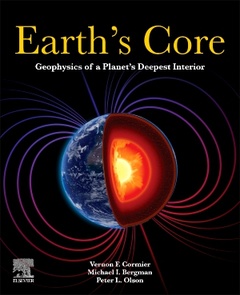Description
Earth's Core
Geophysics of a Planet's Deepest Interior
Authors: Cormier Vernon F., Cormier Vernon F., Bergman Michael I., Bergman Michael I., Olson Peter L., Olson Peter L.
Language: English
Subjects for Earth's Core:
136.70 €
In Print (Delivery period: 14 days).
Add to cart324 p. · 19x23.4 cm · Paperback
Description
/li>Contents
/li>Readership
/li>Biography
/li>Comment
/li>
Earth?s Core: Geophysics of a Planet?s Deepest Interior provides a multidisciplinary approach to Earth?s core, including seismology, mineral physics, geomagnetism, and geodynamics. The book examines current observations, experiments, and theories; identifies outstanding research questions; and suggests future directions for study.
With topics ranging from the structure of the core-mantle boundary region, to the chemical and physical properties of the core, the workings of the geodynamo, inner core seismology and dynamics, and core formation, this book offers a multidisciplinary perspective on what we know and what we know we have yet to discover. The book begins with the fundamental material and concepts in seismology, mineral physics, geomagnetism, and geodynamics, accessible from a wide range of backgrounds. The book then builds on this foundation to introduce current research, including observations, experiments, and theories. By identifying unsolved problems and promising routes to their solutions, the book is intended to motivate further research, making it a valuable resource both for students entering Earth and planetary sciences and for researchers in a particular subdiscipline who need to broaden their understanding.
1. Radial structure of Earth’s core 2. Chemical and physical state of the core 3. Geodynamo and geomagnetic basics 4. Outer core dynamics 5. Boundary regions 6. Inner core explored with seismology 7. Inner core dynamics 8. Formation and evolution of the core 9. Future research goals
Geophysicists, seismologists, and geochemists; graduate students and early career post-doctoral fellows in deep earth geophysics in the sub-fields of seismology, geodynamics, geomagnetism, and mineral physics
Michael I. Bergman is the Emily H. Fisher Professor of Physics at Bard College at Simon’s Rock, where he teaches courses ranging from Introduction to Geology to Solid-state Physics to a field course in Volcanology on the island of Montserrrat. He earned a BA from Columbia University and a PhD from MIT. His research has focused on the solidification and deformation of metals, alloys, and aqueous solutions, with applications to Earth’s core and sea ice. He is the recipient of the Doornbos Prize for research on the deep Earth by a beginning investigator, has been the long-standing secretary of SEDI, and has served as guest editor for several journals.
Peter L. Olson is an adjunct professor in the Department of Earth and Planetary Sciences at the University of New Mexico. He earned a BA from the University of Colorado and a PhD from the University of California Berkeley. His research focuses on the dynamics of Earth and other planets. He co-authored a book on convection in planetary mantles and served on editorial boards of numerous scientific journals. He was elected to the American Academy of Arts and Sciences, the US National Academy of Sciences, and received the Petrus Peregrinus Medal from the European Geosciences Union and the Inge Lehmann Medal from the American Geophysical Union.
- Includes multidisciplinary observations constraining the composition and dynamics of the Earth’s core
- Concisely presents competing theories and arguments on the composition, state, and dynamics of the Earth’s interior
- Provides observational tests of various theories to enhance understanding
- Serves as a valuable resource for researchers in deep earth geophysics, as well as many sub-disciplines, including seismology, geodynamics, geomagnetism, and mineral physics




